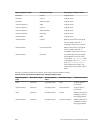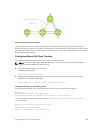
Dell(conf-if-po-32)#switchport
Dell(conf-if-po-32)#lacp long-timeout
Dell(conf-if-po-32)#end
Dell# show lacp 32
Port-channel 32 admin up, oper up, mode lacp
Actor System ID: Priority 32768, Address 0001.e800.a12b
Partner System ID: Priority 32768, Address 0001.e801.45a5
Actor Admin Key 1, Oper Key 1, Partner Oper Key 1
LACP LAG 1 is an aggregatable link
A - Active LACP, B - Passive LACP, C - Short Timeout, D - Long Timeout
E - Aggregatable Link, F - Individual Link, G - IN_SYNC, H - OUT_OF_SYNC
I - Collection enabled, J - Collection disabled, K - Distribution enabled L -
Distribution disabled,
M - Partner Defaulted, N - Partner Non-defaulted, O - Receiver is in expired
state,
P - Receiver is not in expired state
Port Te 10/6 is enabled, LACP is enabled and mode is lacp
Actor Admin: State ADEHJLMP Key 1 Priority 128
To view the PDU exchanges and the timeout value, use the debug lacp command. For more
information, refer to Monitoring and Debugging LACP.
Monitoring and Debugging LACP
The system log (syslog) records faulty LACP actions.
To debug LACP, use the following command.
• Debug LACP, including configuration and events.
EXEC mode
[no] debug lacp [config | events | pdu [in | out | [interface [in | out]]]]
Shared LAG State Tracking
Shared LAG state tracking provides the flexibility to bring down a port channel (LAG) based on the
operational state of another LAG.
At any time, only two LAGs can be a part of a group such that the fate (status) of one LAG depends on the
other LAG.
As shown in the following illustration, the line-rate traffic from R1 destined for R4 follows the lowest-cost
route via R2. Traffic is equally distributed between LAGs 1 and 2. If LAG 1 fails, all traffic from R1 to R4
flows across LAG 2 only. This condition over-subscribes the link and packets are dropped.
518
Link Aggregation Control Protocol (LACP)


















